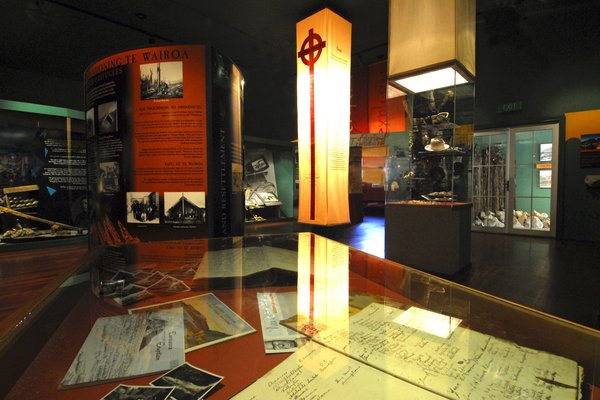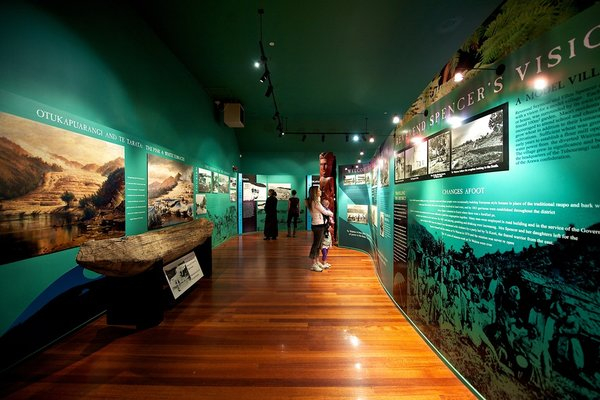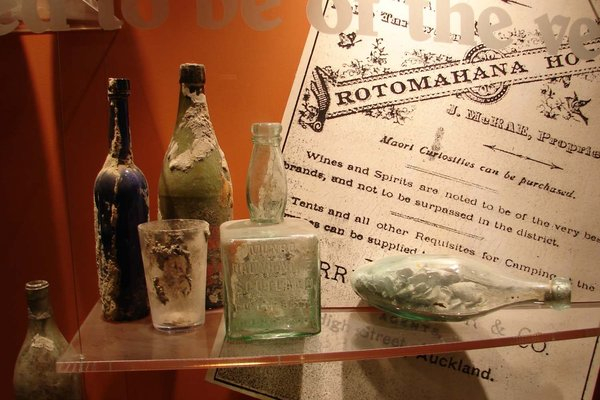Muesum of Te Wairoa holds unique collection
The award-winning culture and heritage attraction, the Museum of Te Wairoa displays the largest collection of excavated objects unearthed following the eruption of Mount Tarawera in 1886. Informative, interactive and entertaining, the museum takes visitors to a time when a once flourishing village was destroyed in one night and how lives and landscape were changed forever.
It’s a devastating and emotional story, told within the walls of the museum. As the most destructive natural disaster in New Zealand’s recorded history, visitors are captivated by the personal accounts of that fateful night.
The Buried Village received the Tourism Innovator Award in 2001/2002 in recognition of their interpretation of heritage within the Museum of Te Wairoa and throughout the archaeological site.
It has taken years of continuous excavation to build the vast collection of recognisable items on display in the museum and each item has been treated with the utmost care and respect. Each relic personalises the story of those caught up in the eruption and the many lives lost.
As they wander through each section of the museum, visitors are taken on a journey from the establishment, growth and ultimately, the destruction of the Te Wairoa Village. The museum's focus on the the finer details give guests the chance to enhance their knowledge in a way that can only be done with its internal resources.
The discovery of truth
The Buried Village was purchased by Reginald and Violet Smith in 1931. Knowing the story of the Mt Tarawera eruption, the couple knew there was a vast amount of history yet to be unearthed. Together with their sons, Dudly and Basil, Reg and Vi began their long but rewarding journey of discovery.
After years of careful excavating, the Smith family has remained committed to uncovering the secrets of Te Wairoa so the events of the fateful eruption are never forgotten.
Over time, the Smiths learnt of many personal accounts of the eruption. These raw and emotional stories are on display in the Te Wairoa Museum today and offer different perspectives on the experience.
From audio-visual presentations to hand-written details, the resources in the Te Wairoa Museum have the ability to bring a new level of understanding to visitors.
A place to tell Te Wairoa’s incredible story
The Te Wairoa Museum goes into great detail about the beginnings and early years of the Te Wairoa Village.
Established as a village by Christian Missionary, Reverend Seymour Spencer, Te Wairoa was a ‘model Maori village’ according to many historic references. Many early photographs suggest the village layout was an interesting combination of Maori and English settlements with traditional whares co-existing with European-style housing.
The news of Te Wairoa’s wonderful attraction, the Pink and White Terraces, quickly spread across the world and the village quickly flourished with and instantaneous tourist boom.
As the museum demonstrates through a number of images and stories, the wealth of the local Tuhorangi Tribe greatly increased and Tour Guiding became a well-paid occupation.
This was a happy time for many of Te Wairoa’s residents as they reaped the financial benefits of the tourism industry. Unfortunately, Mount Tarawera brought an abrupt end to the village and its natural wonder on the night of June 10, 1886.
Resources within the museum describe the grief experienced by the survivors of the eruption and the incredible stories of how they managed to rebuild their lives after such devastation.
Volcanology and the Pink and White Terraces
As the birthplace of tourism in New Zealand, Te Wairoa was home to the attraction that lured tourists to the village, the Pink and White Terraces.
The geological treasures were a layered formation of silica acid and sodium chloride created over a long period of time. They became two magnificent structures that left visitors in awe of the way nature had created such beauty.
The museum is home to a detailed display of how the Terraces looked before the eruption and samples of volcanic rock such as basalt, pumice, silica, obsidian and sulphur. Each sample is accompanied by a description as to the volcanic event that most likely occurred to produce the rock.
Sadly, the museum’s display is as close as you will get to the real thing as the majority of the Terraces were obliterated during the eruption. The remaining pieces were submerged under 60 metres of water when the depth and shape of Lake Rotomahana were dramatically changed.
An extensive range of relics
Once completely buried in mud after Mt Tarawera’s eruption, Te Wairoa is now partially uncovered for you to see at the Buried Village. The mud, once hellish and burning, miraculously acted as a means of preservation for the relics you see on display at the Museum of Te Wairoa today.
With extreme care, the Smith family has been able to excavate the relics and present them in a recognisable state in a special wing at the entrance of the museum. From cooking equipment, to clothing and shoes, the relics tell a story on their own. They help us grasp the concept that these were real people; families, children, the elderly, all completely unaware that their fate was about to change so drastically.
The increasingly valuable collection of relics is one of the main attractions in the museum. Each display is accompanied by a background story and is designed around themes recording aspects of the eruption.
Interesting and fun for all ages
The Te Wairoa Museum has something for everyone. Home to many incredible resources, the museum holds a huge amount of information about the eruption and the story of Te Wairoa before and after the tragic event.
Even the kids will have a great time with the option of heading to the Kid’s Discovery Room. This interactive discovery experience is especially designed for children and is an area where kids can engage in a hands-on archaeological dig, and listen to stories from children living in the village in the 1860s.
With so much to see and do, the Te Wairoa Museum is a great attraction as an individual or with the family. Plan your visit today!











Connect with Us
Facebook YouTube Instagram Tripadvisor Blog Email